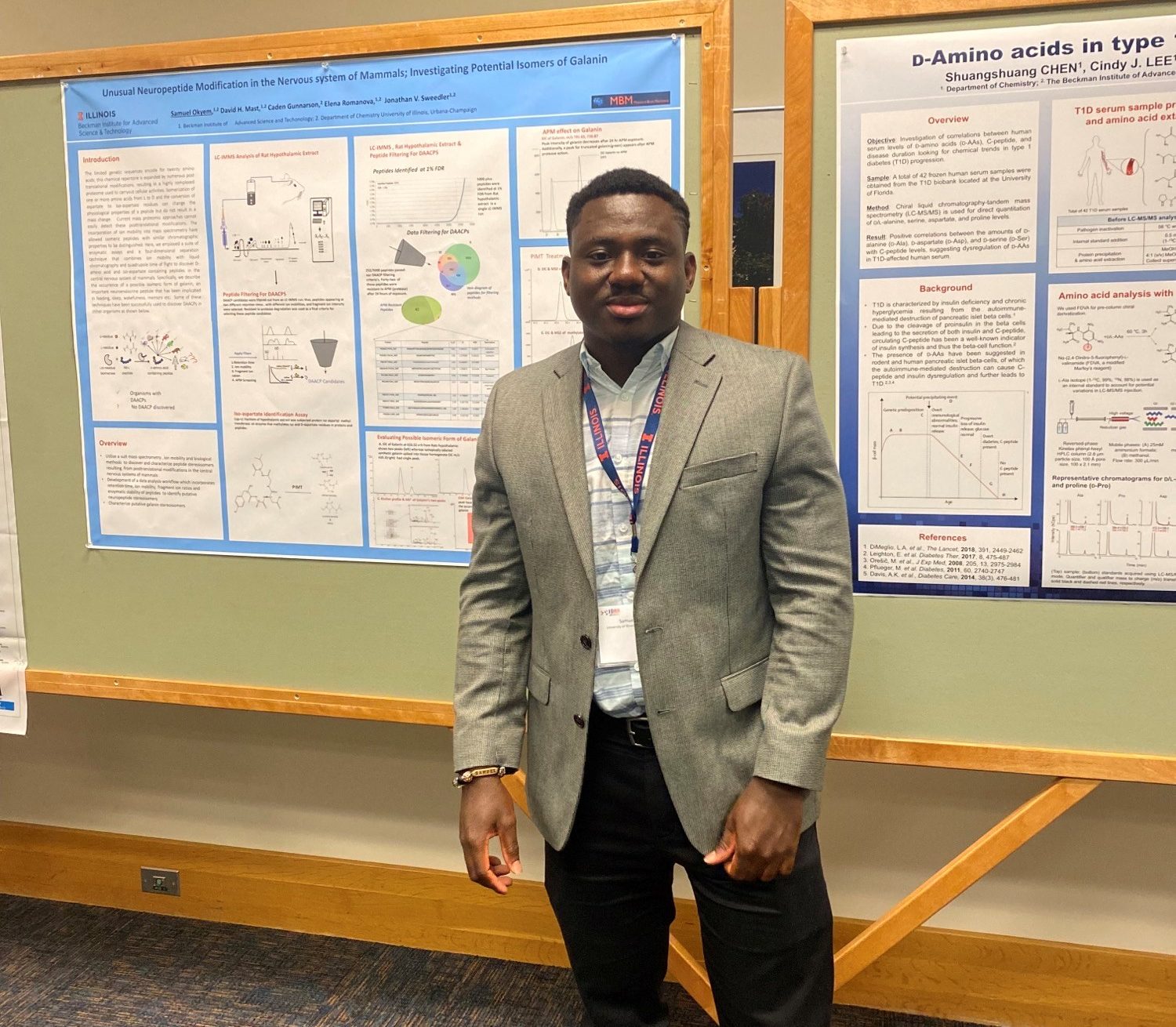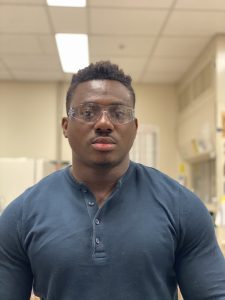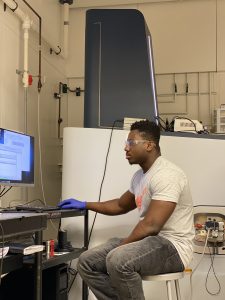 Samuel Okyem joined the program on September 16, 2021, while a second-year student, and is expected to graduate in 2026. His graduate program is chemistry, and he completed his undergraduate degree in chemistry at Kwame Nkrumah University of Science and Technology (KNUST) in Ghana. He also earned a master’s degree in chemistry at Illinois State University. His current research studies the unusual neurochemicals signaling systems related to D-amino acids in the brain. He is completing lab rotations under the advisement of Jonathan Sweedler and Martha Gillette.
Samuel Okyem joined the program on September 16, 2021, while a second-year student, and is expected to graduate in 2026. His graduate program is chemistry, and he completed his undergraduate degree in chemistry at Kwame Nkrumah University of Science and Technology (KNUST) in Ghana. He also earned a master’s degree in chemistry at Illinois State University. His current research studies the unusual neurochemicals signaling systems related to D-amino acids in the brain. He is completing lab rotations under the advisement of Jonathan Sweedler and Martha Gillette.
Okyem has participated in the Special Topics in MBM course as well as other trainee activities such as the MBM Retreat, Summer Journal Club, and Frontiers in Miniature Brain Machinery lectures. He has completed coursework in Integrated Neuroscience and Techniques in Biomolecular Engineering, as well as professional development workshops at the National Organization for the Professional Advancement of Black Chemists and Chemical Engineers (NOBCChE). At this 2022 conference, he also participated in a recruiting session for the Illinois Chemistry program.
In January 2022, he joined the MBM Student Leadership Council, where he served by helping to track down local schools where the MBM Program could conduct outreach to K-12 students. He introduced Frontiers in MBM speakers Catherine Murphy and Todd Coleman in 2022.

In July 2022, Okyem presented a poster on “Unusual Neuropeptide Modification in the Nervous System of Mammals; Investigating Potential Isomers of Galanin” at the Fifth International Conference on D-Amino Acid Research (IDAR2022), where he received the Outstanding Poster Award. His presentation at the 2022 MBM Retreat received an Honorable Mention Award.
In April 2022, Okyem spoke with two classes of science for elementary education students at Illinois State University to explain concepts from his research, which will help the students develop their understanding of scientific concepts prior to teaching. Okyem has also been mentoring two undergraduate students in Jonathan Sweedler’s lab. His other mentorship and outreach include participating in the Mentee C^2 mentorship program at Illinois (2021), and created an educational tutorial on “Measuring Neuropeptides.”
 Research Highlights (in his own words):
Research Highlights (in his own words):
Currently, the identification of D-amino acid containing neuropeptides (DAACP) in the nervous system of mammals is limited. Most of these peptide stereo isomers may have been overlooked since the current MS based peptidomics approaches cannot be used to easily differentiate these peptides. Our group has employed various physicochemical parameters, enzymatic screening, and chromatographic properties to identify DAACP in several lower organisms.
Thus, DAACP candidates are mostly selected by their resistant to protease degradation, elution at multiple retention time, differences in ion mobilities for the peptide eluting at the different retention time, and a change in fragment ion distribution ratio at the different elution times. In our preliminary studies, we identified over 3000 peptides from rats’ hypothalami using LCIMMS. With these large data sets, we developed a python package to filter out possible DAACP candidates using the enzymatic and physicochemical properties discussed above. Approximately 42 peptides passed our filtering criteria as DAACP candidates.
Among these candidates is galanin, a neuroendocrine peptide that has been implicated in feeding, memory formation, sexual behavior, sleep, and wakefulness. We observed two well resolved galanin peaks in an LCIMMS analysis of peptide extracts from the hypothalami of rats. A shift in mobility was also observed for the second galanin peak, which suggests a possible structural difference. From this observation, we hypothesized that galanin may have at least one of its amino acids isomerized. This putative galanin isomer can either result from the presence of an iso-aspartate or D-amino acid residue in the peptide.
 Whereas DAACP form of galanin can only be formed endogenously by an isomerase, aspartate isomerization can occur spontaneously. To this end, an isotopically labelled galanin was spiked into a rat hypothalamic homogenate; the resulting solution was taken through the peptide extraction process followed by LC-IMMS analysis. Extracted ion chromatogram (EIC) of the isotopically labelled galanin was observed at a single retention time coeluting with the first. This observation indicates that no isomerization occurred during the extraction process.
Whereas DAACP form of galanin can only be formed endogenously by an isomerase, aspartate isomerization can occur spontaneously. To this end, an isotopically labelled galanin was spiked into a rat hypothalamic homogenate; the resulting solution was taken through the peptide extraction process followed by LC-IMMS analysis. Extracted ion chromatogram (EIC) of the isotopically labelled galanin was observed at a single retention time coeluting with the first. This observation indicates that no isomerization occurred during the extraction process.
To further probe the occurrence of an endogenous isoaspartate residue in galanin, protein isoaspartyl methyl transferase (PIMT), an enzyme that catalyzes the conversion of isoaspartate to aspartate by methylating iso-aspartate residues leading to the formation of a succinimide intermediate which can be further converted to either aspartate, an iso and or D-aspartate was used. The second galanin peak disappeared when a rat’s hypothalamic peptide extract was subjected to PIMT treatment. This observation gives an indication that galanin may contain an isoaspartate residue.
The occurrence of an isoaspartate residue can either result from aspartate rearrangement or asparagine deamination. Rat’s active galanin peptide has two aspartate and asparagine residues. It is therefore difficult to indicate which one of these residues is converted to isoaspartate. A galanin containing capLC fraction was digested with chymotrypsin to investigate which one of these residues is undergoing isomerization by evaluating the elution profiles and ion mobilities of the resulting fragments. From the results we can infer that the second aspartate residue or asparagine residue may be undergoing isomerization. Our data indicates isomerization in the first or second aspartate or asparagine residue respectively.
Currently, we are developing strategies to confirm which amino acids are isomerized in galanin. Additionally, we are also developing analytical approaches to distinguish between isoaspartate and D-amino acids in neuropeptides. Other neuropeptides determined as possible DAACPs in our preliminary analysis is also being investigated to validate and confirm the occurrence of D-amino acids or isoaspartate in these peptides.
Reflections on the traineeship
The MBM program has exposed me to a variety of scientific research in the neuroscience and bioengineering fields. The lecture series has broadened my knowledge on brain organoids, fMRI, and has shaped my thinking on cellular events that culminates in organ function. Also, the various presentation programs and workshops have improved my presentation skills especially how to tailor my presentation style to a specific audience.

